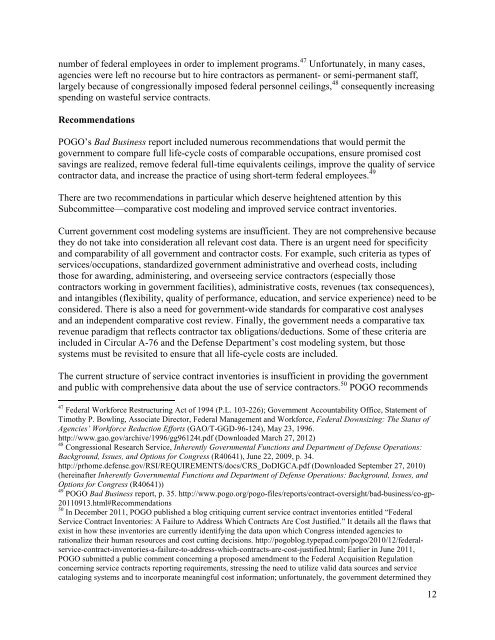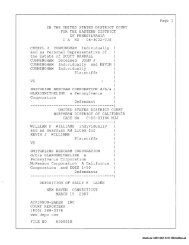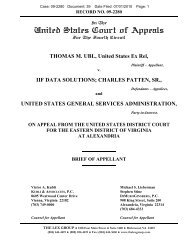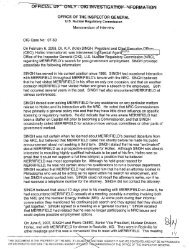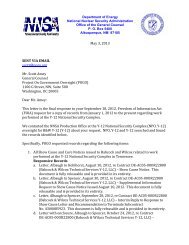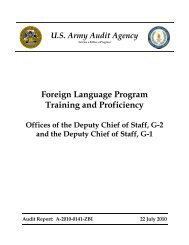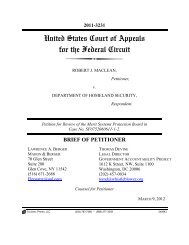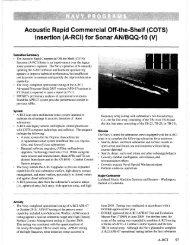SA McCaskill Cost Hearing Final 03 29 12 - U.S. Senate Homeland ...
SA McCaskill Cost Hearing Final 03 29 12 - U.S. Senate Homeland ...
SA McCaskill Cost Hearing Final 03 29 12 - U.S. Senate Homeland ...
Create successful ePaper yourself
Turn your PDF publications into a flip-book with our unique Google optimized e-Paper software.
number of federal employees in order to implement programs. 47 Unfortunately, in many cases,<br />
agencies were left no recourse but to hire contractors as permanent- or semi-permanent staff,<br />
largely because of congressionally imposed federal personnel ceilings, 48 consequently increasing<br />
spending on wasteful service contracts.<br />
Recommendations<br />
POGO’s Bad Business report included numerous recommendations that would permit the<br />
government to compare full life-cycle costs of comparable occupations, ensure promised cost<br />
savings are realized, remove federal full-time equivalents ceilings, improve the quality of service<br />
contractor data, and increase the practice of using short-term federal employees. 49<br />
There are two recommendations in particular which deserve heightened attention by this<br />
Subcommittee—comparative cost modeling and improved service contract inventories.<br />
Current government cost modeling systems are insufficient. They are not comprehensive because<br />
they do not take into consideration all relevant cost data. There is an urgent need for specificity<br />
and comparability of all government and contractor costs. For example, such criteria as types of<br />
services/occupations, standardized government administrative and overhead costs, including<br />
those for awarding, administering, and overseeing service contractors (especially those<br />
contractors working in government facilities), administrative costs, revenues (tax consequences),<br />
and intangibles (flexibility, quality of performance, education, and service experience) need to be<br />
considered. There is also a need for government-wide standards for comparative cost analyses<br />
and an independent comparative cost review. <strong>Final</strong>ly, the government needs a comparative tax<br />
revenue paradigm that reflects contractor tax obligations/deductions. Some of these criteria are<br />
included in Circular A-76 and the Defense Department’s cost modeling system, but those<br />
systems must be revisited to ensure that all life-cycle costs are included.<br />
The current structure of service contract inventories is insufficient in providing the government<br />
and public with comprehensive data about the use of service contractors. 50 POGO recommends<br />
47<br />
Federal Workforce Restructuring Act of 1994 (P.L. 1<strong>03</strong>-226); Government Accountability Office, Statement of<br />
Timothy P. Bowling, Associate Director, Federal Management and Workforce, Federal Downsizing: The Status of<br />
Agencies’ Workforce Reduction Efforts (GAO/T-GGD-96-<strong>12</strong>4), May 23, 1996.<br />
http://www.gao.gov/archive/1996/gg96<strong>12</strong>4t.pdf (Downloaded March 27, 20<strong>12</strong>)<br />
48<br />
Congressional Research Service, Inherently Governmental Functions and Department of Defense Operations:<br />
Background, Issues, and Options for Congress (R40641), June 22, 2009, p. 34.<br />
http://prhome.defense.gov/RSI/REQUIREMENTS/docs/CRS_DoDIGCA.pdf (Downloaded September 27, 2010)<br />
(hereinafter Inherently Governmental Functions and Department of Defense Operations: Background, Issues, and<br />
Options for Congress (R40641))<br />
49<br />
POGO Bad Business report, p. 35. http://www.pogo.org/pogo-files/reports/contract-oversight/bad-business/co-gp-<br />
20110913.html#Recommendations<br />
50<br />
In December 2011, POGO published a blog critiquing current service contract inventories entitled “Federal<br />
Service Contract Inventories: A Failure to Address Which Contracts Are <strong>Cost</strong> Justified.” It details all the flaws that<br />
exist in how these inventories are currently identifying the data upon which Congress intended agencies to<br />
rationalize their human resources and cost cutting decisions. http://pogoblog.typepad.com/pogo/2010/<strong>12</strong>/federalservice-contract-inventories-a-failure-to-address-which-contracts-are-cost-justified.html;<br />
Earlier in June 2011,<br />
POGO submitted a public comment concerning a proposed amendment to the Federal Acquisition Regulation<br />
concerning service contracts reporting requirements, stressing the need to utilize valid data sources and service<br />
cataloging systems and to incorporate meaningful cost information; unfortunately, the government determined they<br />
<strong>12</strong>


